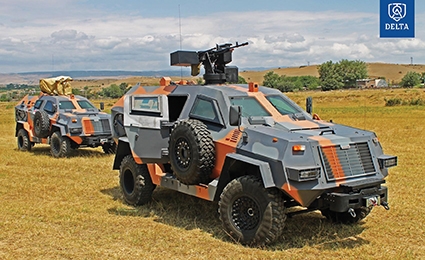Rolling out the Delta Force
Foreign military aid in the form of military training and surplus equipment was given to Georgia in abundance after President Saakashvili rose to power in 2003, and the flow was not stemmed after the 2008 war against Russia; on the contrary, it increased.
However, not willing to be solely reliant on arms from overseas, the Ministry of Defense (MoD) ordered its production wing, STC Delta, to begin producing domestically-designed weapons, munitions and armored vehicles.
Delta began as a wing of Tbilisi Aircraft Manufacturing, a factory that produced droves of planes during the Soviet era but was unable to maintain its output as Georgia became independent and entered a decade of economic turmoil and civil strife.
During this time, Delta itself primarily only produced RPG-7 anti-tank weapons (an infamous Soviet design now mostly associated with terrorist groups due to its prevalence on the black market), which saw use in the civil wars of 1992-1993 and 1998.
In 2010, the MoD drastically increased Delta's funding, and within a year the first members of the Didgori family of armored vehicles had been produced.
Designed to fulfil the role of armored reconnaissance, several variants have been produced, including a command and control vehicle and a heavily-plated medical evacuation wagon. A year later, Delta showcased its first Infantry Fighting Vehicle, the Lazika, which is hoped to eventually replace Georgia's ageing Soviet APC fleet, and fill a gap left by foreign donations; as willing and able Georgia's Western allies are to supply it with surplus rifles and light vehicles, few NATO APCs and IFVs have been given.
Indeed, a main reason the United States has given such vast quantities of its M4 service rifle to its allies is its abundant supply; after the US Army bought the M4 design from Colt outright in 2009, other companies (mostly in the United States, but also in Belgium and Turkey) are now free to produce the weapon. Naturally, this availability does not extend to modern armored vehicles, although Delta did flirt with the idea of producing its own M4 variant in 2012. However, production of the G5 carbine was ultimately canceled due to the vast number of M4s being granted to Georgia, with Delta's budget and time better spent on other, more pressing projects.
Yet despite the G5 never reaching the production line, Delta did not abandon all small arms production, and continues to make sniper systems and heavy-calibre anti-material rifles. It even designs and produces its own optics for the weapons, saving the MoD significant amounts of money on importing scopes and sight systems. In addition, in recent years the Georgian Armed Forces have started using domestically-made helmets and body armor, all produced by Delta.
Delta has also managed to have an impact on the Georgian economy by securing the sale of its armored vehicles abroad. While having made ten deals with foreign countries, the details of the benefactors are classified at this time, with the exception of Saudi Arabia; Riyadh signed a contract worth $40 million to purchase more than 100 Didgori variants.
It is quite possible that Delta's production could undercut Western firms (especially with its armored vehicles and anti-material rifles), selling similar products of comparable quality; Georgia could see a significant boost to its economy if Delta is able to become a competitor to FN, HK, Barrett, Colt and Remington.
However, arguably Delta's greatest contribution to Georgia so far has had little to do with defense or economics. Agriculture remains the largest component of Georgia's economy, especially the country's wine production in Kakheti. Despite the eastern region of the country producing the bulk of Georgia's famous wines, it is racked by stormy weather in the spring and summer months, and hail can be incredibly destructive to crops. Delta-produced chemical rockets are fired from launchers dotted around the region, which detonate within storm clouds. These dissipate chemicals that disrupt the formation of hail, and instead induce rainfall. These rocket systems have proved to be so efficient that they have even attracted the attention of agricultural experts in the United States, who are currently reliant on aircraft to accomplish the same goal.
Tim Ogden











